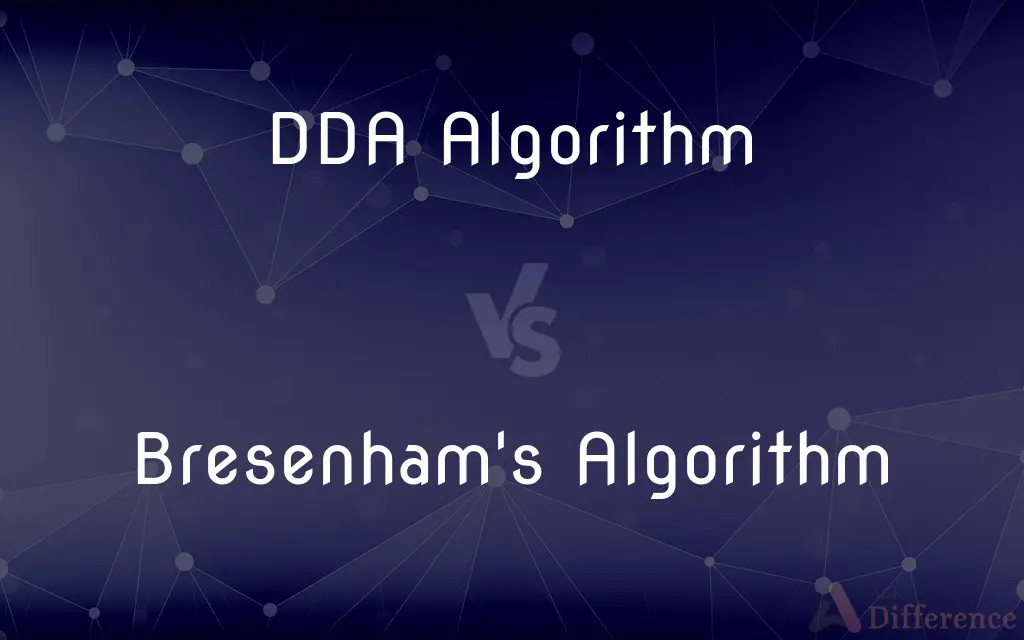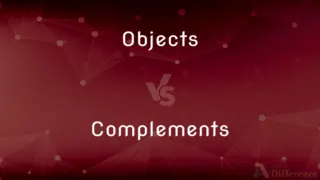DDA Algorithm vs. Bresenham's Algorithm — What's the Difference?
By Tayyaba Rehman — Published on January 28, 2024
DDA Algorithm is a line generation method using floating-point operations, known for simplicity. Bresenham's Algorithm uses integer calculations, more efficient for raster graphics.

Difference Between DDA Algorithm and Bresenham's Algorithm
Table of Contents
ADVERTISEMENT
Key Differences
The Digital Differential Analyzer (DDA) Algorithm is a line generation method that incrementally plots points on a grid based on linear interpolations. It's simple but uses floating-point arithmetic, which can be less efficient on some systems. In contrast, Bresenham's Algorithm, another line drawing method, exclusively uses integer calculations, making it faster and more suitable for raster displays where floating-point operations are costly.
DDA Algorithm calculates both x and y coordinates in each step, which can lead to rounding errors and a less precise line, especially over long distances. Bresenham's Algorithm, however, determines the next point based on the previous point and a decision variable, minimizing errors and producing more accurate and visually appealing lines.
When it comes to simplicity, the DDA Algorithm is more straightforward to understand and implement, as it's based on a simple linear equation. Bresenham's Algorithm, while more complex in its logic involving decision variables, outperforms DDA in terms of efficiency and accuracy.
The performance of DDA is generally slower due to its reliance on floating-point arithmetic. This can be significant in environments where computational resources are limited. Bresenham's Algorithm, with its integer-only approach, is inherently faster and more suitable for real-time graphics rendering where speed is crucial.
Finally, the choice between DDA and Bresenham's Algorithm often depends on the specific requirements of the graphics application. DDA is suitable for applications where simplicity and ease of implementation are priorities, while Bresenham's is the go-to for high-performance raster graphics applications.
ADVERTISEMENT
Comparison Chart
Calculation Type
Uses floating-point arithmetic
Uses integer arithmetic
Accuracy and Error Propagation
Prone to rounding errors; less accurate
Minimizes errors; more accurate
Complexity
Simple and straightforward
More complex due to decision variables
Performance
Slower due to floating-point calculations
Faster, optimized for raster displays
Ideal Application
Suitable for simple applications
Preferred for high-performance graphics
Compare with Definitions
DDA Algorithm
A line generation algorithm using floating-point arithmetic.
The DDA Algorithm smoothly drew the line on the grid.
Bresenham's Algorithm
Ideal for raster graphics where performance is crucial.
For the high-speed rendering requirement, Bresenham's Algorithm was the optimal choice.
DDA Algorithm
Incrementally plots points based on linear interpolations.
Using the DDA Algorithm, each point on the line was calculated based on the previous one.
Bresenham's Algorithm
An efficient line drawing algorithm using integer calculations.
Bresenham's Algorithm quickly rendered the line on the screen.
DDA Algorithm
Can suffer from rounding errors over long distances.
In the DDA Algorithm, the line's accuracy decreased as its length increased.
Bresenham's Algorithm
Utilizes a decision variable to determine the next point.
Bresenham's Algorithm used a decision variable to optimize line plotting.
DDA Algorithm
Suitable for applications where simplicity is key.
The DDA Algorithm was used for its straightforward implementation.
Bresenham's Algorithm
Minimizes rounding errors compared to other algorithms.
The line drawn by Bresenham's Algorithm was remarkably precise.
DDA Algorithm
Simpler but less efficient than other line algorithms.
For a basic graphics project, the DDA Algorithm was an easy choice.
Bresenham's Algorithm
More complex but yields visually appealing results.
Despite its complexity, Bresenham's Algorithm produced excellent graphical output.
Common Curiosities
How does DDA differ in calculation type from Bresenham's?
DDA uses floating points; Bresenham's uses integers.
Is DDA easier to understand than Bresenham's?
Yes, DDA is simpler and more straightforward.
Which algorithm is more accurate?
Bresenham's Algorithm is generally more accurate.
What is the DDA Algorithm?
A line drawing method using floating-point operations for linear interpolations.
What defines Bresenham's Algorithm?
An efficient line drawing method using integer calculations.
Does Bresenham's Algorithm work with all types of graphics?
It's best suited for raster graphics.
Where is Bresenham's Algorithm typically used?
In high-performance raster graphics rendering.
How does Bresenham's Algorithm minimize errors?
By using a decision variable to determine the next point.
Is Bresenham's Algorithm suitable for all line lengths?
Yes, it maintains accuracy over any length.
Which algorithm is faster?
Bresenham's Algorithm is faster due to integer arithmetic.
For which applications is DDA more suitable?
Simple graphics applications where ease of implementation is a priority.
Does DDA suffer from rounding errors?
Yes, especially over longer distances.
Which algorithm requires more computational resources?
DDA requires more due to floating-point calculations.
Can DDA be optimized for better performance?
Some optimizations are possible, but it generally remains less efficient than Bresenham's.
Can DDA be used for real-time graphics?
It's possible but not ideal due to slower performance.
Share Your Discovery

Previous Comparison
Objects vs. Complements
Next Comparison
Volcanic Rocks vs. Plutonic RocksAuthor Spotlight
Written by
Tayyaba RehmanTayyaba Rehman is a distinguished writer, currently serving as a primary contributor to askdifference.com. As a researcher in semantics and etymology, Tayyaba's passion for the complexity of languages and their distinctions has found a perfect home on the platform. Tayyaba delves into the intricacies of language, distinguishing between commonly confused words and phrases, thereby providing clarity for readers worldwide.
















































